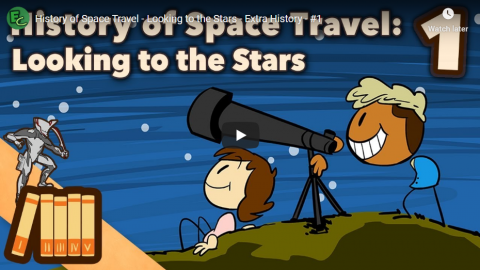Real Engineering
Published 16 Jun 2017Get your Real Engineering shirts at: https://store.dftba.com/collections/r…
Patreon:
https://www.patreon.com/user?u=282505…
Instagram:
https://www.instagram.com/brianjamesm…
Twitter:
https://twitter.com/Fiosracht
Website:
http://www.RealEngineering.netThank you to my patreon supporters: Adam Flohr, darth patron, Zoltan Gramantik, Henning Basma, Karl Andersson, Mark Govea, Mershal Alshammari, Hank Green, Tony Kuchta, Jason A. Diegmueller, Chris Plays Games, William Leu, Frejden Jarrett, Vincent Mooney, Ian Dundore, John & Becki Johnston. Nevin Spoljaric
Once again thank you to Maeson for his amazing music. Check out his soundcloud here: https://soundcloud.com/maeson-1/tracks
January 31, 2020
Why The US Military Made GPS Free-To-Use
January 15, 2020
QotD: Louis XIV and the first accurate maps of France
In our current age of apps, able to tell us exactly where we are in the world at any time, it’s hard to imagine an era in which most people would never have seen a map. The average English person of the mid-sixteenth century would have had little idea of the overall shape of their own country, let alone a foreign one. And even the merchants and elites who did have access to maps did not have an entirely accurate picture. Before the systematic adoption of trigonometric surveying, as well as the ability to accurately calculate longitude by observing Jupiter’s moons using telescopes, the process involved a lot of guesstimation. When the new techniques were introduced towards the end of the seventeenth century, the results could come as quite a shock. Louis XIV, when shown a revised map of his country, allegedly remarked that he had lost more land to his astronomers than to his enemies. France was a lot thinner than everyone had supposed.
Anton Howes, “The House of Trade”, Age of Invention, 2019-11-13.
November 9, 2019
History of Space Travel – Revolutions – Extra History – #2
Extra Credits
Published 7 Nov 2019Start your Warframe journey now and prepare to face your personal nemesis, the Kuva Lich — an enemy that only grows stronger with every defeat. Take down this deadly foe, then get ready to take flight in Empyrean! Coming soon! http://bit.ly/EHWarframe
As the Renaissance breathes new life into Europe, Copernicus develops mathematical proofs for the sun resting in the center of the universe. And from his works, a new world is born. The scientific world gets faster and faster. Revolutions of all kinds begin to set off chains of events that reshape human history. And as science improves, so do the tools of war. Both will be necessary to propel humanity to the stars. Join us on this race through the scientific works between the Renaissance and the Industrial Revolution.
Copernicus’ publishing really came down to the wire! Legend has it that he was given the final printed pages on his death bed. When they presented him with the book, he awoke from a coma, saw his life’s work and finally passed away in peace. Or so the story goes.
November 2, 2019
History of Space Travel – Looking to the Stars – Extra History – #1
Extra Credits
Published 31 Oct 2019Start your Warframe journey now and prepare to face your personal nemesis, the Kuva Lich — an enemy that only grows stronger with every defeat. Take down this deadly foe, then get ready to take flight in Empyrean! Coming soon! http://bit.ly/ECWarframe
What do Ptolemy and ancient Chinese rockets have in common? Without either of these things, space flight wouldn’t be possible! In order to understand how we started traveling amongst the stars, we have to talk about how we started studying stars in the first place. Since the very first civilizations we’ve always looked at the night sky with wonder & curiosity but also as a way to try and understand the future and time itself.
October 31, 2019
A mathematical revolution in late medieval English ship design and construction
In the latest installment of Anton Howes’ newsletter on the Age of Invention, he discusses how geometry and mathematics helped transform late Medieval English shipbuilding:

An English ship of a slightly later period: this is a replica of the Susan Constant at the Jamestown Settlement in Virginia. The original ship was built sometime before 1607 and rented by the Virginia Company of London to transport the original settlers to Jamestown.
Photo by Nicholas Russon, March 2004.
Since about 1500, an Italian and Portuguese method of making ships had come into ever wider use in northern Europe. This was to construct the ship’s skeleton first, and then lay the planking around it. This contrasted with the older “clinker” method, by which the planks were laid from the keel upwards, with each plank slightly overlapping the one below – the rest of the skeleton was filled in later to strengthen it. The new “carvel” method, instead of having overlapping planks, allowed for a smooth hull. But it also required more planning.
The master shipwright had to first design full-sized templates, or frames, which were placed along the keel to determine the width and height of the hull, like cross-sections up and down the length of the ship. To the edges of these frames were then fixed ribbands — long, pliable boards running down the ship’s length. Altogether, the frames and ribbands formed a temporary, basket-like structure, to guide the moulding of the ship’s permanent hull around it.
But calculating the size of the frames at each point was tricky. After the placement of the first few, which might be pre-specified in size, the next ones along were typically determined according to the curve of the ribbands. Calculation was certainly involved, but it took place in the form or marking and adjusting the wood itself. Design and construction both took place in the shipyard, and through the medium of wood.
What Matthew Baker did in the 1570s was to take the design process out of the shipyard, and onto paper. He drew his ships, to scale. And by using pen and paper, with geometry to make such drawings possible, he opened up grand new possibilities for design. His process allowed him to jot down the latest innovations from the Mediterranean, to speculate about the designs of Noah’s ark and the ships of the ancient world, and to cheaply conduct his own experiments. He drew out new designs for frames, using geometry to work out how any variation would affect the overall shape of the hull, as well as its weight and carrying capacity – all at the cost of only time, ink, and paper, and avoiding the huge potential waste of conducting experiments at full scale in wood. His process allowed him to innovate more easily, and even to design new measuring instruments.
October 24, 2019
When the English (finally) met Euclid
In the latest Anton Howes newsletter on the Age of Invention, he relates the introduction of Euclid’s geometric ideas to the English:
Almost all of the late sixteenth-century English innovations seem to involve the application of geometry, following the maxims set down almost two thousand years earlier by Euclid of Alexandria. (Though at the time, most people mistakenly attributed his work to the even more ancient philosopher Euclid of Megara.) Manuscripts of Euclid’s work had circulated in western Europe throughout the Middle Ages, but was only accessible to the handful of people who could read Latin, or the even fewer who could read Arabic or ancient Greek. In 1482, however, the Latin version was printed in Venice, and throughout the sixteenth century it was translated into more and more modern languages.
The full edition would eventually appear in English in 1570, but Euclid’s geometry was revealed to English-speakers much earlier, through the intervention of the mathematician Robert Recorde. Recorde embarked on a project to comprehensively unveil the mysterious mathematical arts in print. He started in 1543 with The Ground of Arts, a basic introduction to arithmetic, which in 1551 he followed up with The Pathway to Knowledge, an introduction to geometry. Once the ground had been stood upon, and the pathway to knowledge had been followed, there was then a Gate of Knowledge (on practical geometry, sadly now lost), which revealed a Treasure of Knowledge (also lost, but presumably also on applied geometry), which was then kept in a Castle – you guessed it – of Knowledge (on applying the learning from the other books to some complex astronomical instruments). At this point he apparently ran out of places to go with his metaphor, returning in 1557 with a book on advanced arithmetic called the Whetstone of Wit. He unfortunately died the following year.
But his Pathway of Knowledge was the first book to introduce English-speakers to Euclid’s geometry. In fact, it was the first book in English on geometry ever. And he wrote it in a way that he thought would be more accessible than reading Euclid raw. The effect was revolutionary. He created the market for books on mathematics, opening the way to books on its applications by common gunners and navigators and makers of navigational instruments, as well as by scholars. And geometry began to creep into invention after invention. Recorde’s Pathway extolled the seemingly extraordinary achievements of the ancients – Archimedes, Daedalus, and others – which he argued had all been made possible by their understanding of geometry. Naturally, it inspired others to emulate or even exceed them.
July 23, 2019
QotD: Science of the ancient Greeks
… discussions that mention the Great Library and/or the supposed impact of Christianity on “progress”, with the idea being that the Scientific and Industrial Revolutions were due on some kind of inevitable deterministic historical timetable but were wantonly derailed “for a thousand years” by the destruction of the Great Library, which is supposedly why we don’t live on the moons of Jupiter.
The problem with all this is not just that the scholars of the Mouseion were rather more interested in the textual variants of Pindar’s paianes than studying physics, but also a common modern misunderstanding about the nature of Greek “science”. Many modern people, including modern scientists, hear about the Greeks discussing motion or “atoms” or doing geometry to measure the circumference of the Earth or the distance to the Sun and assume that they were doing “science” in the modern sense of the word. Historians also sometimes refer to Greek natural philosophy as “science” and popularisations of the history of science draw simplistic direct lines between things like Greek discussions of “atoms” and modern atomic theory. But this obscures the fact that Greek proto-science was, while a distant lineal ancestor of the modern sciences, very unlike them in many important respects. At best, it was a highly rational attempt at understanding fundamental precepts of the physical and natural world. But it used induction and common sense more than measurement and experiment. There were exceptions (mainly in geometry and its related field, astronomy), but the Greeks were usually not interested in empirical measurement and so were usually even less interested in genuine experiments. Most Greek proto-science was a highly abstract and philosophical affair, based on some observations, but without modern ideas of carefully designed and repeatable experiments with calibrated measurement and attendant mathematics. Most of their “science” was done by sitting around, thinking and talking about concepts, not by actually dropping weights from towers – though they did do thought experiments which sometimes led to correct conclusions and sometimes did not. Their “science” was not our science.
This means that a Greek conversation about “atoms” was largely an abstract and metaphysical exercise about the philosophical nature of a thing and how many times it could be divided conceptually and what this may mean; the word comes from the Greek ἄτομος meaning “unhewn, uncut, indivisible”. No Greek philosopher walked away from such a conversation and decided to try to build some equipment to explore the physical nature of atomic structure and would probably have considered such an idea absurd. Nor would they have taken the step of considering that different forms of matter, liquid or gas were made up of different combinations of atoms and so decide to experiment with these substances to understand this better, since this was completely contrary to their (erroneous) conception of the “Four Elements” of Earth, Air, Water and Fire. The nature of Greek thought did allow them to draw useful and often correct conclusions about the physical universe, but it also set up barriers to the true scientific method that they simply did not and could not cross.
This was one of the reasons there was no direct link between their proto-scientific “science” and technology. Natural philosophy was, as the term would suggest, the preserve of philosophers. In a world where most of the population had to be devoted to agricultural production and most of the rest often barely got by, sitting around and talking about abstractions like “atoms” was a rich man’s luxury. Most philosophers either came from the upper class (though maybe its lower echelons in many cases) or had rich patrons or both, which meant most philosophers had little interest in making or inventing things: that was generally the preserve of lowly mechanics and slaves. Again, there were exceptions to this – Archimedes seems to have had some interest in the engineering applications of his ideas, even if most of the inventions attributed to him are probably legends. On the whole, however, lofty Greek philosophers didn’t think to soil their hands with something as lowly as inventing and making things.
Tim O’Neill, “The Great Myths 5: The Destruction Of The Great Library Of Alexandria”, History for Atheists, 2017-07-02.
July 22, 2019
QotD: Vivid vacation memories
While on an adventurous holiday, many people experience that strange sense of time having slowed down in the most pleasurable way, and of conversations that begin, “Was it really only yesterday that we …?”
Ten days in a far-off land produces a richer treasury of detailed memories than 10 weeks back home. But what is behind this phenomenon? And does it teach us something about living a full life?
One answer comes from Claude Shannon, a titan of computer science still under-appreciated outside his field. In 1948, Shannon published one of his two profound contributions, A Mathematical Theory of Communication.
One of the implications of Shannon’s theory is that a message can be compressed to the extent that it is predictable. Anyone who has played the guessing game of Hangman knows that once a few letters are in place, the remainder are usually easy to guess. Similarly: sntnces wth vwls rmvd sty cmprhsbl. Ritualised conversations (“How are you?” “Very well, thank you. How are you?”) can be heavily compressed; poetry, perhaps, less so.
A movie can be compressed because, between cuts, each frame tends to resemble the previous one. A compression algorithm can start with the first frame after the cut and store a series of “diffs” — changes from the previous frame. The faster and more dramatic the movement or transitions, the harder a video is to compress, because the diffs are almost as big as the original frames.
Although the parallel is not exact, much the same thing seems to be going on with our memories of life. The brain is not a video recorder; we recall the gist. Sometimes the gist is very brief. If I get up in the morning at the usual time, eat my customary breakfast and catch my usual train to the office, why should my brain trouble itself to remember this day two weeks after the fact? The diffs are barely worth bothering with. In contrast, fresh experiences defy compression: the diffs are too big.
Tim Harford, “Why going on holiday gives us more memories”, Financial Times, 2019-04-26.
June 24, 2019
The idea of “infinity”
David Warren, staunch man of the 13th century, might be termed an opponent of the notion of infinity:
The term “infinity” was an invention of the Devil. This, gentle reader will understand, is my humble opinion. Or if the Devil didn’t invent it, he “evolved” it, from the more innocent usages that conveyed “unlimited,” or “countless,” or “unknowably” large or small. What is finite has an ending, can be finished, finis. What is infinite cannot be; it is open-ended. There is, where we look for an end, nothing there.
Nothing is quite the opposite of something. Perhaps this is a fact no longer taught in our schools: that “nothing” can do nothing for you. Whereas, “something” might. For in its modern usage, “infinity” has become a thing. It has become “virtually” an agent, a kind of god, demanding to be worshipped. The very Christian idea of Alpha and Omega — from the first to the last letter of the (Greek) alphabet, from beginning to end — is subtly replaced in our minds with the progressive idea, “from one to infinity.”
Which is where the human mind checks out. “So what is infinity plus one?” one asks. There can be no answer. Today we are hanging on a cross of “infinity.”
The mathematician Georg Cantor (1845–1918), in his lucid moments (when out of insane asylums), invented set theory. It may be found, lodged in the heart of post-modern reasoning. My hero Wittgenstein, among others, explained how pernicious it was. Scholastic theologians had already spotted the fly in the “infinite” ointment. It is pantheist, and in Cantor’s “final” posit of an infinity of infinities, it is a direct challenge to the unity or uniqueness of the revealed God. Cantor himself was under the impression that God existed, in the sense that God had communicated set theory to Cantor of all people. I, at least, am sceptical of those who claim direct communication with God, especially those who spend a lot of time in bat houses, and wonder with whom they were really chatting. (I don’t doubt that the mad can be brilliant, however.)
November 1, 2018
QotD: Game theory
“Guys,” he writes. “It’s time for some game theory.” Game theory, for the uninitiated, is a branch of mathematics that uses computational models to predict the behavior of human beings in potentially conflictual situations. It’s complex, involves a lot of formal logic and algebra, and is mostly useless. Game theory models human actions on the presumption that everyone is constantly trying to maximize their potential gain against everyone around them; this is why its most famous example concerns prisoners — isolated people, cut off from all the noncompetitive ties that constitute society. One of its most important theoreticians, John Nash, was also a paranoid schizophrenic, who believed himself to be the target of a vast Russian conspiracy.
Sam Kriss, “The Rise of the Alt-Center: Why did establishment liberals fall in love with a deranged Twitter thread? It’s time for some game theory”, Slate, 2016-12-16.
July 2, 2018
History of Non-Euclidean Geometry – Lies – Extra History – #6
Extra Credits
Published on 30 Jun 2018You gently corrected out our math mistakes and artistic slip-ups, and we’re here to tell you it was all part of Bismarck’s plans—er, it’s Euclid’s fault. Time for another episode of Lies!
June 25, 2018
The History of Non-Euclidian Geometry – The World We Know – Extra History – #5
Extra Credits
Published on 23 Jun 2018Up until the 20th century, people assumed light behaved like a wave, passing through the “aether wind” — a fluid with incomprehensible properties. When the Michelson-Morley experiment disproved the aether’s existence, Einstein put out the theory of relativity — that space and time were part of the same package.
It’s 1887. Physics is almost complete. We almost know enough to see the clockwork of the universe. Only one last great question remains: how does light travel?
June 19, 2018
The History of Non-Euclidian Geometry – A Most Terrible Possibility – Extra History – #4
Extra Credits
Published on 16 Jun 2018In the early 19th century, people started to wonder if the Fifth Postulate couldn’t be proven at all — meaning that it could be right, but it could also be wrong. Bolyai, Lobachevsky, and Riemann started exploring hyperbolic geometry and other strange realms…
June 11, 2018
The History of Non-Euclidian Geometry – Squaring the Circle – Extra History – #3
Extra Credits
Published on 9 Jun 2018Euclidean geometry eventually found its way back into Europe, inspiring René Descartes to create the Cartesian coordinate system for maps, and Isaac Newton to invent calculus. Both these tools helped humanity understand the world better.
June 4, 2018
The History of Non-Euclidian Geometry – The Great Quest – Extra History – #2
Extra Credits
Published on 2 Jun 2018For hundreds of years, Euclid’s geometry disappeared with the fall of the Roman Empire. But in Constantinople, Islamic mathematicians, including Al-Khwarizmi (who gave us the word “algebra”) worked long and hard on proving the Fifth Postulate.








